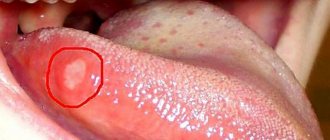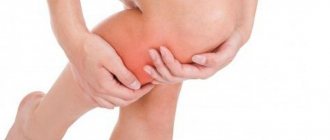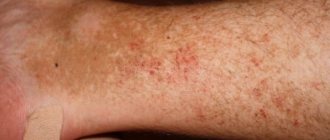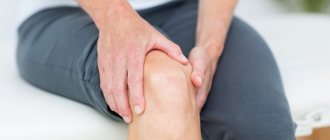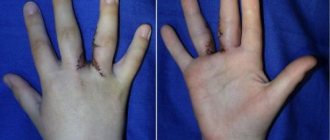Causes and mechanisms
The appearance of white spots on the skin is mainly due to a change in normal pigmentation. Areas where there is less melanin appear lighter than the surrounding areas. And among the causes of such hypopigmentation you can most often find:
- Vitiligo.
- Pityriasis versicolor.
- Guttate hypomelanosis.
Weakening of color in certain areas occurs after inflammatory pathology (psoriasis, lupus erythematosus, neurodermatitis, scleroderma), as a result of burns, injuries or exposure to chemicals. Hypopigmentation sometimes turns out to be syphilitic or leprosy leukoderma, a consequence of genetic abnormalities or helminthic infestation. As you can see, there are many reasons for the appearance of white spots on the lower extremities and each case should be considered individually.
Itchy spots on the lower legs
Sometimes when using a new type of skin care product or a new clothing powder, your skin may become red and itchy. This indicates contact dermatitis. This skin condition occurs when chemicals that the human body comes into contact with cause a reaction.
Most contact dermatitis reactions are not serious, but they can be uncomfortable until the itching goes away.
There are three types of contact dermatitis:
- allergic contact dermatitis;
- irritant contact dermatitis;
- photocontact dermatitis.
Photocontact dermatitis is less common. This is a reaction that can occur when the active ingredients in a cosmetic product cause irritation after sun exposure.
Allergic contact dermatitis occurs when the skin reacts to a foreign substance. This causes the body to release special chemicals that can cause feelings of itching and irritation.
Common causes of contact dermatitis may include:
- perfumes or chemicals in cosmetics and foot care products;
- poison ivy or other plants.
Symptoms
It is difficult to say why lesions with reduced pigmentation appear on the legs without examination. But by consulting a doctor, the patient can be confident that he will receive an answer to his question. First, anamnestic information is obtained, and then the affected areas are examined. A preliminary diagnosis is based on the results obtained.
Vitiligo
Spots completely devoid of melanin are characteristic of vitiligo. The nature of the disease is not fully understood, but autoimmune, hormonal, hereditary and external factors are assumed to be involved in its development. First, a single white spot of various shapes forms on the soles of the feet or another area of skin. It can maintain its size for a long time - then they speak of a stable phase of the disease. If its diameter increases and new foci of depigmentation appear, then progressive vitiligo is confirmed.
The spots that appear do not cause any subjective sensations. They lack melanin, so they are prone to redness when exposed to sunlight. As a rule, vitiligo is only a cosmetic defect, but if it develops, the patient should be examined for possible abnormalities in the functioning of the body.
With vitiligo, depigmented lesions form, which can cover large areas of the skin.
Pityriasis versicolor
White spots on the feet can appear with pityriasis versicolor (lichen versicolor). This is a pathology caused by a fungal infection of the stratum corneum of the epidermis (keratomycosis). The spots with lichen initially have a pink-yellow-brown color, but under the sun they do not tan, so they become lighter. They tend to merge and form large lesions with scalloped edges.
The favorite localization of spots is the skin of the torso, but elements of the rash can also be located on the lower extremities (especially in children). Lichen versicolor does not bring any subjective discomfort; only slight itching is possible. The spots are accompanied by fine-plate peeling, which can be revealed by light scraping. Without treatment, the disease can last for a long time, causing relapses.
Guttate hypomelanosis
Another condition that causes white patches to appear on the skin of the legs is guttate hypomelanosis. Light dots, not exceeding 10 mm in diameter, are localized mainly on the flexor surfaces of the knee or elbow joints. Mostly middle-aged women suffer from this type of pigmentation disorder. The spots have smooth outlines, never merge with each other and are not accompanied by subjective symptoms.
Psoriasis
The consequences of various dermatoses of inflammatory origin can also look like hypopigmentation. Lighter areas, including on the feet, can form during the period of resolution of psoriatic plaques. The latter first look like flat, bright red papules with a scaly surface. But in the progressive stage, the elements increase in size and cover increasingly larger areas of the skin.
Psoriatic lesions most often resolve with the formation of hypopigmented spots that disappear over time.
Most common places of education
Most often, the location of plantar warts is the periungual area, the joints of the fingers and the sole. The size of the neoplasm can range from 2 to 10 mm, and in some cases, warts can grow up to 2 cm in diameter. The lump grows deeper and rises only slightly above the skin. Warts can be either single or numerous mosaic, fused with each other and forming a bizarre “mosaic” pattern.
We invite you to familiarize yourself with Treatments for varicose veins in the salon
A dermatologist can make an accurate diagnosis, classify the disease and prescribe effective treatment. For a more accurate diagnosis, it may be necessary to remove the upper, keratinized layer of the epithelium and study the compaction under a microscope.
Additional diagnostics
It will be possible to understand why white spots appear on the sole or other parts of the lower extremities after a comprehensive examination. Based on the probable causes and results of the medical examination, a diagnostic program is formed, which may include:
- General and biochemical blood tests.
- Serological tests (presence of antibodies).
- Study under a mercury-quartz Wood lamp.
- Iodine test.
- Microscopy and seeding of particles taken during scraping.
- Histological analysis, etc.
Sometimes it is necessary to exclude disorders of the internal organs, which instrumental studies will help with. Some patients need consultation not only from a dermatologist, but also from an immunologist, endocrinologist or geneticist. And only the results of a comprehensive diagnosis will give grounds to assert the reasons for which white spots appeared on the legs. And this, in turn, opens up the possibility of adequate therapy.
Red spots on legs: Varicose veins
Varicose veins are a terrible curse of the modern woman. Poor nutrition, excess weight, uncomfortable shoes and tight clothing lead to impaired blood circulation in the lower extremities. One of the alarming symptoms of the onset of varicose veins can be spots on the legs.
The walls of blood vessels and capillaries become thinner, and with minimal load they burst, causing hemorrhages. As a rule, varicose spots are dark wine-colored and can merge. If you do not contact a phlebologist in time, there is a risk of developing subcutaneous hematomas, which can only be removed promptly.
The doctor will be able to select a set of measures for the treatment and prevention of varicose veins, such as:
- drugs that strengthen the walls of blood vessels;
- mineral and vitamin complexes;
- a balanced diet (especially if you are overweight);
- compression garments (if necessary);
- a set of physical exercises and procedures.
Features of white spots on legs
The appearance of white spots on the skin of the legs is associated with a disruption in the production of melanin, the substance responsible for coloring. This may be caused by a decrease in the functional activity of melanocytes - cells that synthesize melanin, or their absence in certain areas of the skin. Melanin accumulates in the surface layer of the skin - the epidermis. Due to its deficiency or excess, pigment spots (birthmarks) and moles appear on the body, including on the legs.
This is facilitated by various factors: the level of stress on the feet, poor hygiene, wearing uncomfortable shoes or untimely treatment of foot fungus.
Red spots on legs: Stress and poor diet
Some types of spots are called hemorrhagic; they are caused by pinpoint hemorrhages in the upper layers of the skin. Most often this occurs due to a lack of vitamins in the body. So, with a deficiency of vitamins PP, C or A, dark, almost brown spots appear on the legs, but an insufficient amount of vitamin B is expressed in the appearance of lighter areas of the skin. The treatment of vitamin deficiency should be approached comprehensively. The doctor will prescribe the necessary medications for you, but it is also important to enrich your diet with fruits and vegetables, try to give up bad habits, normalize your daily routine and get proper rest.
Causes
Let us consider the causes of spots on the feet that are common in medical practice.
- Fungal infection. This type of pathogen can cause the appearance of red or white spots on the legs. When the level of fungal infection reaches its maximum, a pathology known as shingles may occur. The causative agent of the disease is a type of yeast called Candida. This disease affects young people with increased levels of sebaceous gland production. Shingles is characterized by the appearance of white spots under the skin on the legs or arms in those places where the infection is localized, itching and an unpleasant odor.
- Pigmented nevi. This disease ranks first among the causes of the formation of white spots on the skin. It is associated with an insufficient amount of melanin production by specific cells, as a result of which small white formations or spots appear on the skin, the size of which is no more than 10 mm.
When the disease develops, small single dots unite and form several large, chaotically located spots. Pigmented nevi differ from vitiligo in that they do not spread to other areas of the epidermis.
They do not show any pathological signs characteristic of other skin diseases (no local wetting of the spots or, on the contrary, excessive dryness, pungent odor, itching, rough surface). A child may also develop a pigmented nevus. We are talking about a chronic skin disease that occurs due to a lack of melanin. The results of scientific studies conducted on this category of patients indicate that melanin is not completely absent in babies, but is produced in insufficient quantities.
- Vitiligo. Irreversible damage to melanocytes occurs in certain areas of the body. At the initial stage of development of the disease, the appearance of discolored dots on the skin is observed. Then they begin to gradually increase. On the legs, vitiligo usually affects the area from the feet to the knees. All age categories are susceptible to the onset of the disease. The risk group includes patients suffering from diabetes or thyroid diseases.
- Lenticular hypopigmentation. A distinctive feature is the appearance of white spots with smooth edges on the body, shaped like confetti. Lenticular hypopigmentation appears in middle-aged people exposed to the sun for a long time. Women who do not tolerate tanning well or who abuse solariums are predisposed to the appearance of this type of spots. The etiology of the disease has not yet been studied in detail. Apart from a cosmetic defect, lenticular hypopigmentation does not cause harm to health (it does not itch or cause pain).
- Pregnancy. Often pregnant women complain of the appearance of white spots on their legs or arms. Women in this situation mistakenly believe that this is due to damage to the small vessels of the legs. The process is caused by a hormonal imbalance in the body. In most cases, with the birth of a child, the problem goes away on its own, which means that the woman does not need to use any medications. If the spots do not disappear within a year after giving birth, you need to seek help from a dermatologist.
Other reasons
If we exclude common causes, the appearance of white spots on the skin may be associated with the following situations:
- use of low-quality cosmetics (creams, tonics, lotions);
- after shaving the skin;
- leading a sedentary lifestyle (for example, when you stand on your feet or sit for a long time), which leads to poor circulation in the lower part of the body;
- wearing tight clothing, which causes excessive sweating;
- unbalanced diet, lacking vitamins and microelements.
Any of these factors can lead to a decrease in melanin synthesis, which inevitably causes hypopigmentation.
Do not immediately panic when you discover white spots on your legs and arms. The first thing you need to do is visit a dermatologist to rule out any serious diseases after the examination.
Only after finding out the cause can you begin treatment, which will be prescribed by a specialist.
Separately, it is worth highlighting information about the appearance of white spots on the legs and other parts of the body in children. In most cases, this is caused by the following diseases:
- Hypomelanosis. It makes itself felt in the first years of life after infectious diseases.
- Tumorous sclerosis. It is a signal of more serious problems in the body (epilepsy, mental retardation, damage to some internal organs).
Prevention measures
Timely treatment of the underlying disease will prevent the spread of white spots. Treatment should be supervised by a doctor.
If white spots are associated with intense exposure to sunlight, then it is appropriate to use products that protect against a painful photoreaction.
If white areas appear, you should consult a specialist, as this may be not only an aesthetic flaw, but also a symptom of an internal or dermatological disease. Particular attention should be paid to such signs if white spots appear on the legs of a child or infant.
Anomalies of the human skin, their causes and classification have a wide range of definitions. This factor complicates the diagnosis of the disease and treatment procedures. White spots on the heels are a defect that may turn out to be a disease.
Kinds
Depending on the cause of the appearance, the spots differ significantly from each other. They come in different sizes, colors, numbers, and reproduction.
Let's look at the spots associated with a disease such as varicose veins of the lower extremities. They may vary in color; below we will describe what types of spots there are.
Red spots
Quite often they are even bright red. Usually small in nature, very reminiscent of “freckles”. Mainly affected areas are the lower legs and feet. At the same time, they do not bring any discomfort, but if you do not start treatment, the disease progresses and at the same time you begin to feel itching, burning, dry skin, and swelling. The reasons for the appearance of such spots are:
- diabetes;
- infectious diseases of the skin;
- blood clots (on veins);
- CVD diseases.
Red spots on legs
Pink spots
It is quite difficult to judge the appearance of pink spots, since they are quite rare causes of varicose veins. One of the reasons is venous insufficiency, but, basically, they indicate other diseases not related to varicose veins.
Pink spots on legs
Red-brown spots
This type of spots occurs as a consequence of a progressive disease, and no treatment is performed. This color indicates the initial stage of the necrotic process. Varicose veins develop and this significantly reduces blood circulation in the legs. This type of spots is dangerous because they can develop into eczema, atrophy and other quite severe complications.
Red-brown spots on legs
Blue-red spots
This coloring is an indicator of the transition of the disease to a chronic form. At the same time, the veins are quite changed and dilated. All this may be a consequence of anemia.
Blue-red spots on legs
Blue spots
These spots are a consequence of complications of varicose veins such as thrombophlebitis. In addition, they may indicate a blood clotting disorder. If you notice spots of this color, you should immediately consult a doctor and begin the necessary treatment. These spots may not be a consequence of the onset of the development of varicose veins, but may result from:
- severe lack of vitamin C;
- burst small capillaries;
- thin vascular walls (fragility of the walls).
Blue spots with varicose veins
These spots can also appear due to:
- excess body weight;
- after incorrect depilation;
- constantly wearing high-heeled shoes;
- allergic reaction (cream, medicine and much more);
- lichen spots (the main reason for the formation of spots is a greatly reduced immune system).
Do not be confused, the disease (lichen) contributes to the formation of spots such as:
- Pink rashes where there is a clear outline of red color are pityriasis rosea.
- Small purple rash - rash - lichen planus.
- Red, inflammatory areas accompanied by the formation of blisters are herpes zoster.
- Quite pale rashes that tend to peel are called pityriasis versicolor.
- Red spots that cause severe discomfort in the form of itching and burning, and often hair loss, are ringworm.
Remember that you still shouldn’t ignore visiting your doctor if you have small red spots.
What do white spots indicate?
The appearance of white spots on the feet indicates the occurrence of disorders in the human body. Externally, they can take different forms.
A) Large flat spots or corns:
- as a result of wearing uncomfortable shoes;
- due to flat feet and excessive pressure on the foot;
- due to dry skin of the feet and insufficient elasticity.
B) A spot in the form of a callus - from uncomfortable shoes.
C) Formations in the form of tubercles on the heel of the foot, usually white in color:
- may protrude above the skin;
- have a flat shape and do not protrude outward;
- in the form of small dots-nodules;
- gray or brown flat plaques are “senile” plaques.
D) White plaque on the feet as a change in skin pigmentation.
E) White spots with holes or dots are another subtype of skin disease.
E) Cracks in the heel or other part of the sole.
All of them are related to cosmetic phenomena, but the causes of their occurrence should be sought with the help of a dermatologist.
The presence of external manifestations on the skin often indicates the papilloma virus, which makes it unpleasant and painful to move. The virus is transmitted through contact of carrier objects with damaged areas of the skin (cracks). Activation of activity occurs against the background of a general weakening of the immune system or as a result of a nervous shock experienced.
The spots, called white, may also have other colors. They are divided into vascular - their appearance is caused by various inflammatory processes, and pigmentary - due to a reaction to ultraviolet rays. Or due to changes occurring within the body.
The list of possible diseases is extensive:
- evidence of incipient varicose veins of the lower extremities are hemorrhagic spots;
- fuzzy, reddened areas that itch or itch - this is erythema;
- causeless hematomas, blue dots indicate the presence of vascular pathologies and a lack of vitamin C;
- small flaky sheets, and the skin underneath becomes denser - this is roseola;
- the appearance of areas of skin of a paler color (whitish coating) than the rest of the skin may be one of the signs of infection with syphilis.
Dry patches with scales
Pink, raised, dry patches on the body and head may indicate psoriasis. With this dermatological pathology, raised plaques appear on the skin of a person - psoriatic papules. They protrude above the surface of the skin, cause intense itching and flake, and tend to spread and coalesce.
Psoriasis is a chronic autoimmune disease in which rashes are most often localized on the elbows, head, knees and groin. Dry pink spots covered with white scales are foci of chronic inflammation. Under the influence of internal autoimmune processes, epidermal cells divide several times faster than necessary. As a result, small flakes of dying skin cells are constantly separated.
Causes and symptoms of appearance
The absence of pain due to the appearance of white spots on the feet in the form of a small spot or a large area has a cosmetic etiology. A qualified specialist will tell you this.
One of the most common diseases causing such manifestations is vitiligo. It is also the cause of the appearance of white spots on a child’s skin, as well as pityriasis.
The condition of the skin depends on the functional health of the human liver, which synthesizes melanin. The work of the gallbladder and biliary tract affects the pigmented appearance. An ultrasound examination will give an answer about the condition in this part of the body.
Other pathologies
When spots on the leg itch (photo below), the cause may be several other common diseases.
These include:
The listed diseases lead in frequency of occurrence (after allergic reactions and mycoses).
With psoriasis, the rash is localized mainly on the bends of the arms and legs. Moreover, spots can appear on the scalp, as well as on the entire body. Rarely do they affect the face. The lesion may also involve the nail plates. The spots appear and go away spontaneously. Their appearance is not provoked by food, materials, etc. The general condition of the patient does not change.
If the spot on the leg does not itch or hurt, this is one of the symptoms of psoriasis. At the same time, its surface peels off. If itching occurs with diagnosed psoriasis, additional examination is necessary. This indicates the development of other pathologies against the background of this disease.
One of the types of mycoses is pityriasis rosea. This type of disease is not contagious (unlike regular fungal infections of the feet). Most often, the appearance of such a disease is explained by a weakened immune system. The spot has an uneven shape and peels off. Itching is moderate.
Another disease whose symptoms are rashes and spots on the skin is eczema. It can be in acute or chronic form. Eczema spots may be red and flaky. Sometimes papules appear on the skin. Sores may appear in areas where clothing rubs against the skin (for example, between the legs, under the armpits).
Another cause of this condition may be atopic dermatitis. The spots in this case are swollen and flaky. Their outline is blurry. Under the influence of cold, the disease develops more actively. When heated, the skin becomes cleaner.
Localization Features
White spots appear on different parts of the skin of the body, but in most cases they affect the lower limbs and heels. This statement will be especially true for corns, cracks, calluses and warts. The heel localization of the above types is explained by the fact that the main reasons for their appearance are problems associated with walking and the load on this part of the foot.
Treatment methods
When diagnosing the occurrence of vitiligo (diseases of internal organs, etc.), the original cause should be eliminated in order to normalize the functioning of these organs and the endocrine system. Use special procedures to get rid of parasites, sedatives to stabilize the patient’s nervous activity.
The remedies offered by traditional healers are either difficult to prepare (according to one recipe, an infusion of medicinal herbs requires 21 types of plants plus lemon zest and 2 liters of vodka) or inconvenient to use (treating stains with your own urine). Drug therapy appears to be more effective and practical.
Infantile vitiligo is treated with steroid creams or medications (Psoralen (P) in combination with ultraviolet light sessions.
For white spots in the form of warts use:
- freezing methods (liquid nitrogen) for tissue necrosis and subsequent peeling;
- treating the affected area with cantharidin;
- stimulation of the immune system;
- the drug Amiquinod for the production of antibodies by the patient’s body to fight the papilloma virus;
- cutting off the tubercles with a scalpel, electric needle or cauterization with a laser device is a surgical treatment, but leaves scars.
Treatment
Therapy for the disease should be comprehensive and include not only treatment with medications, but also physical procedures and dietary nutrition.
Conservative
If rashes in the form of white spots appear on the legs, then apply local treatment to the affected areas. It is not possible to completely get rid of the defect, but many cosmetic procedures help to visually reduce the size of the formations.
One of the treatment methods is exposure to UV rays. To stimulate pigmentation processes, rubbing melagenin lotion into problem areas before the procedure is recommended. The result is noticeable after some time: the spots on the skin initially acquire a reddish tint, and later darken and do not differ in color from the surrounding tissues.
Medicines
The treatment regimen and selection of drugs should be carried out by the attending physician after establishing the cause of the disease.
Systemic treatment includes taking the following medications:
- Short course hormonal drugs. The use of the drug is prescribed both in tablets and topically in the form of creams or ointments.
- Immunostimulants to strengthen the body's defenses.
- Medicines that improve the functioning of the digestive system.
- Agents that restore metabolic processes in the liver and pancreas.
- Vitamins and minerals.
- For frequent stress - soothing teas, antidepressants.
- Antifungal creams.
- Antihistamines.
- Antibiotics, antiparasitic drugs.
Risk factors and complications
The risk range for white spots in their variety of shapes and types is wide. The health of your legs and feet depends on caring for this part of the body. The main, most reliable means of protection against the disease is a healthy lifestyle, in which the functioning of the internal organs and nervous system is not subject to negative external influences. This remedy will best protect the body from the introduction of disease from the outside.
From the list of complications that arise as a result of the illness, it is worth highlighting the danger of developing flat feet and the appearance of spinal disease (with corns). No less serious is the development of hyperkeratosis (from excess keratin). There may be calluses in the space between the toes, which lead to fungal infections and a similar disease of the toenails. Holes (holes similar to ulcerative lesions) may appear in the keratinized tissue of the heels.
The causes of hyperkeratosis are similar to the causes of the appearance of white spots in the form of corns or calluses, cracks. If a white coating appears on the heels, this may be the cause of the disease. It causes inconvenience to a person, and treatment requires considerable effort.
Risk of occurrence during pregnancy
White subcutaneous dots on the legs during pregnancy indicate a violation of melanin synthesis or blood microcirculation. Melanin production is disrupted due to restructuring of a woman’s endocrine system under the influence of sex hormones. This does not pose a danger to the baby or mother. In this case, the spots are a cosmetic defect that does not require treatment. They go away after childbirth.
If the problem is the tone of the blood vessels in the legs, it can also recover after childbirth. If this does not happen, treatment with medications and physical therapy is needed. It is recommended to be regularly monitored by a doctor. For a pregnant woman and child, the pathology does not pose a danger.
Other causes of white pimples on the leg and spots:
- penetration of infection, development of inflammation;
- white insect bites;
- autoimmune diseases;
- intoxication.
Bites cause acne due to allergens in the insect's saliva. Having penetrated the bite point, the substance causes swelling, itching, and hyperemia. This can be observed with mosquito bites. If insects have bitten a child, do not let him scratch or squeeze out the white pimples.
Hygiene rules and prevention
Treatment of age spots on the heels caused by excessive physical impact on these parts of the body is carried out by making changes in foot care (massage, medicinal baths, medicated ointments, timely pedicures). Changing shoes to ones that are comfortable for walking, regularly performing gymnastic exercises for the feet, and daily hygiene procedures will help. Important proactive actions will be maintaining a comfortable neuropsychological state and restraint in nutrition to maintain a physiologically normal body weight.
White spots on the feet require careful diagnosis and examination of the body. If it becomes painful to step on for no reason, or formations appear on the skin, consult a doctor to rule out the presence of pathologies.
How to get rid of spots on feet
You cannot self-medicate. You need to visit a dermatologist if suspicious formations appear.
You can get rid of white spots on the skin of your feet in several ways:
The conservative method is aimed at eliminating secondary points caused by inflammation or allergies. For this purpose, antibiotics, enzymes, hormonal, antihistamine, antifungal drugs, and vitamins are used.
Medicines are used in the form of ointments, tablets, injections. Sometimes detoxification therapy is required.
Hardware and surgical methods are more effective. Common ones are cryodestruction, laser. Exposure to cold or a directed beam on the cells of the pathological white point destroys it, a crust forms on this part of the leg, under which the wound heals and normal skin is restored.
Dermatology deals with the study of various skin problems. White spots on the legs may also be a reason to contact a specialist. Why they may occur and what other symptoms to expect from a probable pathology should be asked by your doctor. Only a specialist is able to conduct a high-quality examination and make a diagnosis.

